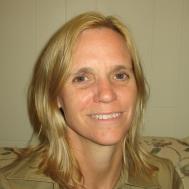
Valerie Ramseyer
Associate Professor of History
Medieval historian of southern Italy and the Mediterranean, with special interest in the relationship between Christian, Muslim, and Jewish communities.
My research focuses on southern Italy and Sicily in the early and central Middle Ages (c. 500-1200 AD). I chose to study southern Italy because it is a cultural and religious crossroads, with communities of Greek and Latin Christians, Muslims, and Jews, as well as immigrants from a variety of European and Mediterranean regions. My research also takes a comparative approach whenever possible, integrating the history of southern Italy and Sicily into the larger contexts of Mediterranean and European history. I published a book in 2006 entitled The Transformation of a Religious Landscape: Medieval Southern Italy, 850-1150 that examined religious life and organization in the Lombard Principality of Salerno in the late Lombard and early Norman eras. My current book project, entitled "Lombards and Greeks, Arabs and Normans: Southern Italy in the Early Middle Ages", is a study of the political, religious, economic, and social structures of southern Italy and Sicily in the early Middle Ages (c. 500-1100 AD), comparing and contrasting regions under Latin, Byzantine, and Arab rule.
I teach a wide range of courses on the history of Europe and the Mediterranean from c. 300-1300 AD. My courses cover all aspects of life in the Middle Ages: political, religious, social, economic, and cultural. Topics of my courses include the fall of the Roman empire and the establishment of the barbarian kingdoms in late antiquity; the history of Byzantium and Islam in the early Middle Ages; the Carolingian empire and its successor states; Europe in the high Middle Ages; heresy and popular religion; religious persecution and the crusading movement; and the history of medieval Italy. I also teach a seminar on 12th-century Europe.
In addition to my publications, I present papers on a regular basis at conferences and in recent years I have organized sessions for the annual meetings of the American Historical Association, the Medieval Academy of America, and the International Conference on Medieval Studies held in Leeds, U. K. I have also translated texts and articles from both Latin and Italian.
Recent Publications:
“Rethinking Boundaries between Christian, Jewish, and Muslim Communities in Pre-Lateran Southern Italy," in Irven Resnick and Marie-Thérèse Champagne (eds.), Religion and Law in Medieval Christian and Muslim Societies (Brespols, 2018)
“Questions of Monastic Identity in Medieval Southern Italy and Sicily, c. 500-1200," in the New Cambridge History of Medieval Western Monasticism, Alison Beach and Isabelle Cochelin (eds.) (Cambridge University Press, 2020)
“Diversity, Mobility, and Connectivity in the Beneventan Zone,” in Brill Companion to the Beneventan Zone, Andrew Irving and Richard Gyug (eds.) (forthcoming Brill)
COURSES
HIST208 Society and Culture in Medieval Europe
HIST213 Conquest and Crusade in the Medieval Mediterranean
HIST214 Medieval Italy
HIST222 The Barbarian Kingdoms of Early Medieval Europe
HIST279 Heresy and Popular Religion in the Middle Ages
HIST330 Seminar: Revolutiona nd Rebellion in Twelfth-Century European Society
HIST379 Heresy and Popular Religion in the Middle Ages
Education
- B.A., Smith College
- M.A., University of Chicago
- Ph.D., University of Chicago
Current and upcoming courses
Heresy and Popular Religion in the Middle Ages
HIST379
This course looks at popular religious beliefs and practices in medieval Europe, including martyrdom and asceticism, saints and relics, shrines, miracles, and pilgrimage. It seeks to understand popular religion both on its own terms, as well as in relationship to the church hierarchy. It also examines the varied and changing roles of women in Christianity, Christian ideas regarding gender and asexuality, passionate same sex relations in monastic culture, and saints associated with LGBTQ communities. It ends by examining the growth of religious dissent in the 11th and 12th centuries, which led to religious repression and the emergence of what some historians refer to as a persecuting society in 13th-century Europe. This course may be taken as HIST 279 or, with additional assignments, as HIST 379.
-
Heresy and Popular Religion in the Middle Ages
HIST279
This course looks at popular religious beliefs and practices in medieval Europe, including martyrdom and asceticism, saints and relics, shrines, miracles, and pilgrimage. It seeks to understand popular religion both on its own terms, as well as in relationship to the church hierarchy. It also examines the varied and changing roles of women in Christianity, Christian ideas regarding gender and asexuality, passionate same sex relations in monastic culture, and saints associated with LGBTQ communities. It ends by examining the growth of religious dissent in the 11th and 12th centuries, which led to religious repression and the emergence of what some historians refer to as a persecuting society in 13th-century Europe. -
Saints and Sinners in the Middle Ages
WRIT167
In medieval Europe, biographies of saints were one of the most popular forms of literature, providing readers and listeners with examples of saintly behavior to emulate and sinful actions to avoid. More importantly the biographies narrated the lives of some of the most important members of medieval society. Whether living or dead, saints were seen as liminal beings able to move between this world and the next, communicating God’s will to their fellow Christians and harnessing divine power to perform miracles. This course will examine the lives of a diverse group of male and female saints from the Middle Ages (c. 300-1300 C. E.), utilizing the sacred biographies both as a means for understanding medieval society and as a springboard for addressing larger issues connected to the aims and function of biographical writing and the question of whether or not an “objective” biography is ever possible.